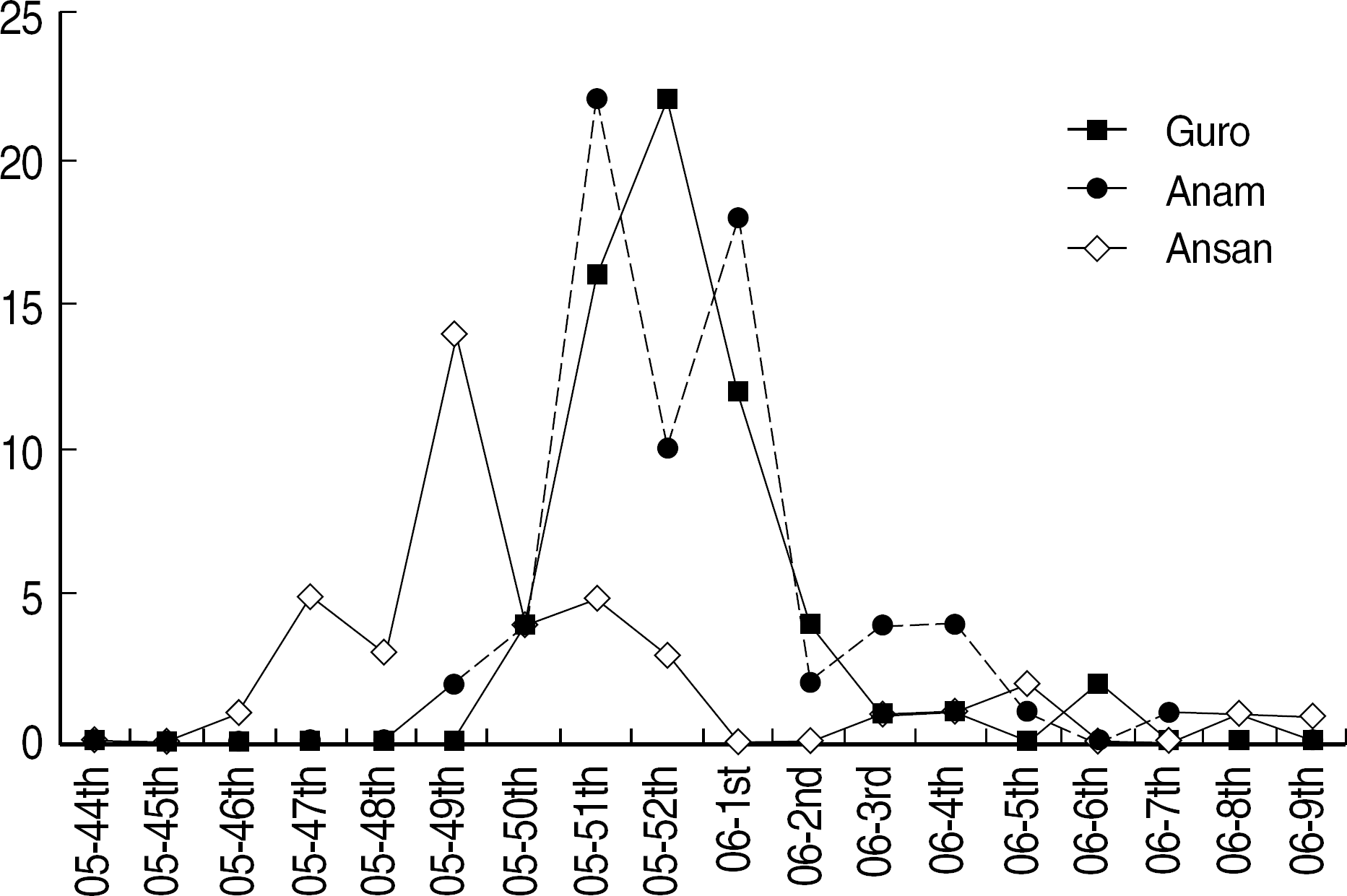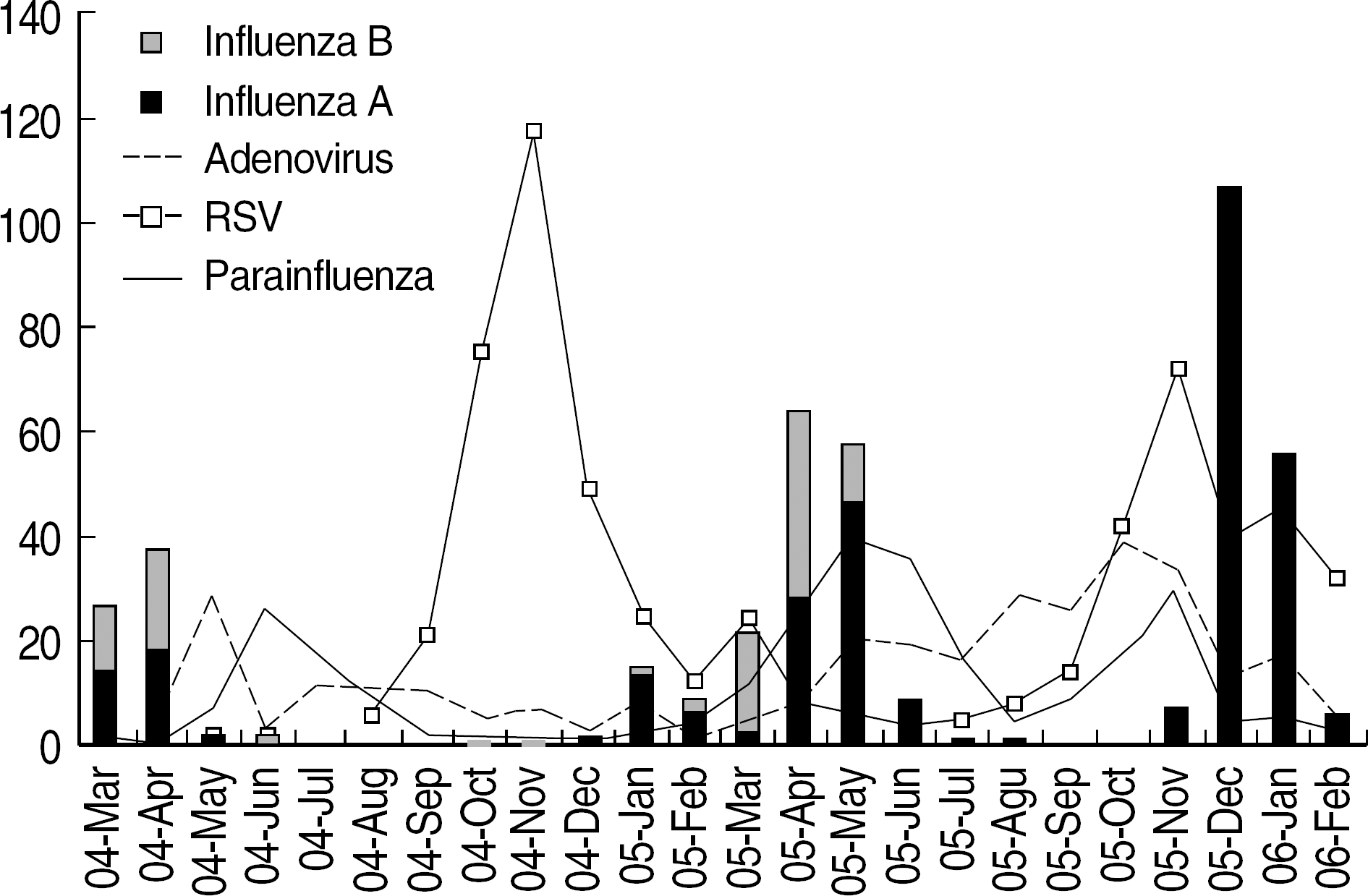Abstract
Background
The information on the incidence, seasonal variation and clinical pattern of respiratory virus infections is very important for clinicians in managing their patients. This study was aimed to define the epidemiology of respiratory viral pathogens in Seoul and the neighboring areas from March 2004 to February 2006.
Methods
A total of 6,533 specimens were cultured for respiratory viruses during the study period. Madin-Darby canine kidney (MDCK), LLC-MK2, and HEp-2 cells, or R-mix cells (Diagnostic Hybrids Inc., Athens, Ohio, USA) were used for culture. Influenza virus types A & B (Inf A & B), parainfluenza virus (PIV), respiratory syncytial virus (RSV), and adenovirus (ADV) were identified by indirect immunofluorescent staining. Medical records of the patients with positive virus cultures were reviewed retrospectively.
Results
One or more viral agents were isolated from 1682 specimens (25.7%). The pathogens identified were RSV 37.2%, ADV 19.9%, Inf A 18.9%, PIV 17.5% and Inf B 6.4%. The most frequent pathogen of pneumonia and acute bronchiolitis was RSV and that of croup was PIV. Upper respiratory tract infections were more prevalent in adults and the most frequently caused by influenza virus. Influenza virus itself was more frequently isolated in children less than six years old, which was different from previous reports. Influenza virus was mostly isolated in the winter and spring, while RSV was usually isolated from early fall with a peak incidence in the winter. Inf A and RSV showed a dampening effect on the occurrence of other viruses during their major epidemic. PIV was mostly detected in the spring and summer. ADV was isolated throughout the whole year.
References
1. Organizacion Panamericana de la Salud. Nuevo programa de enfermedades no transmisibles de la OPS: el predominio mundial y regional de las enfermedades no transmisibles/New non-communicable diseases program at PAHO: the global and regional predominance of non-communicable diseases. Bol Epidemiol. 1995; 16:6–8.
2. Garbino J, Gerbase MW, Wunderli W, Deffernez C, Thomas Y, Rochat T, et al. Lower respiratory viral illnesses: improved diagnosis by molecular methods and clinical impact. Am J Respir Crit Care Med. 2004; 170:1197–203.
3. Selwyn BJ. The epidemiology of acute respiratory tract infection in young children: comparison of findings from several developing countries. Coordinated Data Group of BOSTID Researchers. Rev Infect Dis. 1990; 12:S870–88.
4. Shann F. Etiology of severe pneumonia in children in developing countries. Pediatr Infect Dis. 1986; 5:247–52.

5. Bonner AB, Monroe KW, Talley LI, Klasner AE, Kimberlin DW. Impact of the rapid diagnosis of influenza on physician decisionmaking and patient management in the pediatric emergency department: results of a randomized, prospective, controlled trial. Pediatrics. 2003; 112:363–7.

6. Berman S, Duenas A, Bedoya A, Constain V, Leon S, Borrero I, et al. Acute lower respiratory illnesses in Cali, Columbia: a two-year ambulatory study. Pediatrics. 1983; 71:210–8.
7. Maletzky AJ, Cooney MK, Luce R, Kenny GE, Grayston JT. Epidemiology of viral and mycoplasmal agents associated with childhood lower respiratory illness in a civilian population. J Pediatr. 1971; 78:407–14.

8. Ruutu P, Halonen P, Meurman O, Torres C, Paladin F, Yamaoka K, et al. Viral lower respiratory tract infections in Filipino children. J Infect Dis. 1990; 161:175–9.

9. Sunakorn P, Chunchit L, Niltawat S, Wangweerawong M, Jacobs RF. Epidemiology of acute respiratory infections in young children from Thailand. Pediatr Infect Dis J. 1990; 9:873–7.

10. Denny FW, Clyde WA Jr. Acute lower respiratory tract infections in nonhospitalized children. J Pediatr. 1986; 108:635–46.

11. Park HY, Lee NY, Lee JS, Jung EH, Lee SJ, Ahn KM, et al. An epidemiological study of acute viral lower respiratory tract infections in hospitalized children from 1996 to 2002 in Seoul, Korea. Pediatr Allergy Respir Dis. 2003; 13:216–26.
12. Gubareva LV, Kaiser L, Hayden FG. Influenza virus neuraminidase inhibitors. Lancet. 2000; 355:827–35.

13. Hwang YO, Seo BT, Choi BH. Analysis of isolation and subtyping of influenza virus in Seoul, during 1999–2003. J Bacteriol Virol. 2004; 34:67–74.
14. Lee MY, Gong YW, Oh BY, Jung SH, Kim HY, Lee JM. Epidemiological analysis of influenza by laboratory surveillance in Incheon, 2003/2004–2004/2005. Korean J Clin Microbiol. 2005; 8:165–71.
15. Tseng RK, Chen HY, Hong CB. Influenza virus infections in Taiwan from 1979 to 1995. Jpn J Med Sci Biol. 1996; 49:77–93.

17. Nah SY, Park SE, Park JY, Lee HJ. Epidemiology of influenza virus over 8 years (1990–1998) in Seoul, Korea. Korean J Infect Dis. 1999; 31:210–6.
18. Hall CB, Douglas RG Jr. Respiratory syncytial virus and influenza. Practical community surveillance. Am J Dis Child. 1976; 136:615–20.
19. Denny FW, Murphy TF, Clyde WA Jr, Collier AM, Henderson FW. Croup: an 11-year study in a pediatric practice. Pediatrics. 1983; 71:871–6.

20. Muller-Pebody B, Edmunds WJ, Zambon MC, Gay NJ, Crowcroft NS. Contribution of RSV to bronchiolitis and pneumonia-associated hospitalizations in English children, April 1995-March 1998. Epidemiol Infect. 2002; 129:99–106.
21. Jeon NL, Kim BS, Hong SJ, Kim YK. Etiology and clinical features of severe acute viral lower respiratory tract infections in children. J Korean Pediatr Soc. 2000; 43:1558–68.
22. Lee SY, Oh JW, Lee HB, Lee HR, Ahn KM, Lee SI. Epidemiology of childhood viral respiratory tract infections in Seoul. Pediatr Allergy Respir Dis. 1999; 9:100–8.
23. Lee HJ, Yun BY, Kim ML, Yun JG. Viral etiology and epidemiology of actue lower respiratory tract infections in children. Korean J Infec Dis. 1995; 27:319–32.
24. Irmen KE, Kelleher JJ. Use of monoclonal antibodies for rapid diagnosis of respiratory viruses in a community hospital. Clin Diagn Lab Immunol. 2000; 7:396–403.

25. Pyo JW, Lee HJ. Adenoviral respiratory tract infections in children. Korean J Infect Dis. 1996; 28:493–501.
Fig. 2.
The local distribution of influenza virus type A from November, 2005 to February, 2006. Ansan showed earlier epidemic of influenza virus type A than other areas.

Table 1.
Prevalence of viral pathogens according to age
Table 2.
Prevalence of causative viruses according to clinical diagnosis in pediatric patients




 PDF
PDF ePub
ePub Citation
Citation Print
Print



 XML Download
XML Download